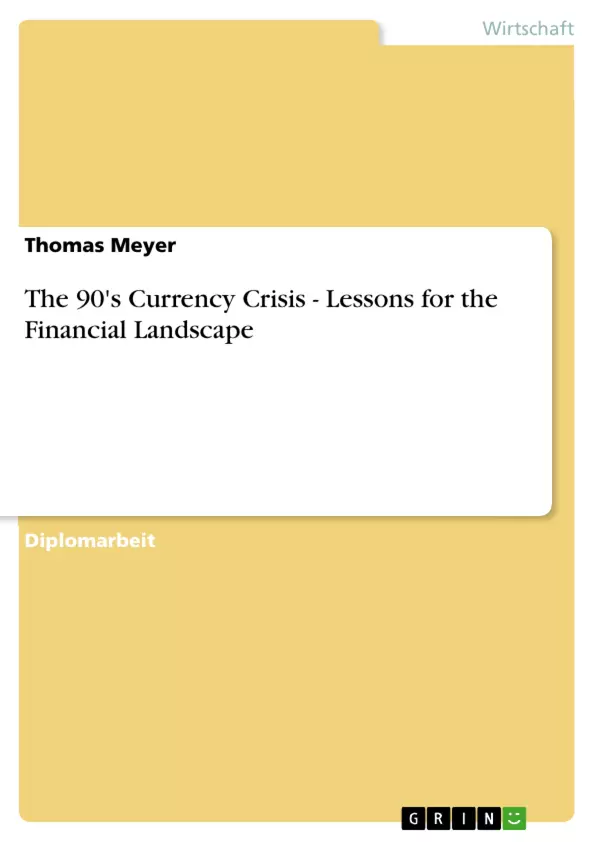When on June 2nd 1997 Thailand devalued its currency, the stage was set was the most severe and virulent currency crisis of that decade. The sudden reversal of capital flows depleted economic wealth and social cohesion in many East Asian countries, hitherto perveived to belong to the Asian Miracle. Shockwaves of the crisis were felt in most emerging markets, even those outside the region, and reached mature markets when, for instance, the hedge fund Long-Term Capital Management nearly collapsed. In face of these enormous costs, this paper analyses the possibilities and boundaries of attempts to either reduce the likeliness of respective financial shocks or, when unavoidable, lower the costs of managing these crises.
On the ground of the state-of-the-art models of currency crises it is examined which domestic or international factors contributed most to the observed outcome. The guiding question is if either moral hazard considerations, in the form of governmental guarantees and alike, or approaches of multiple equilibria are more suited to serve as an explanation. Moreover, this paper illuminates the significance of the original sin hypothesis which states that emerging markets are constrained when trying to borrow abroad in domestic currency or, even when trying at home, to borrow long-term. Although it is acknowledged that all these factors are valid simultaniously, superior importance in the following parts is given on the multiple equilibria approach.
Inhaltsverzeichnis
- Introduction
- Understanding Currency Crises
- The Path from the Canonical Model to Moral Hazard
- Multiple-Equilibria and Financial Panic
- At the Core of the Problem: The Exchange-Rate Regime
- Currency Pegs versus Floating Exchange Rates
- Dollarization as an Alternative
- At the Center of the Problem: Liquidity
- The Need for Liquidity or an International Lender of Last Resort
- Insurance and Credit Facilities against Systematic Risk
- Capital Controls
- Controls on Capital Outflow
- Taxes on Capital Inflows
- At the Heart of the Problem: The Institutional Framework
- International Bankruptcy Standards
- Regulation and Transparency
- Collective-Action Clauses in Financial Contracts
- Importance of Foreign Ownership
- Different Currency Crises and Remedies
- Summary and Conclusions
Zielsetzung und Themenschwerpunkte
Die Diplomarbeit analysiert die Währungskrisen der 1990er Jahre und zieht daraus Lehren für die Finanzlandschaft. Sie untersucht die Ursachen und Folgen dieser Krisen, insbesondere in Schwellenländern, und beleuchtet die Rolle von Wechselkursregimen, Liquidität und institutionellen Rahmenbedingungen. Die Arbeit zielt darauf ab, ein tieferes Verständnis für die Mechanismen von Währungskrisen zu entwickeln und Handlungsempfehlungen für die Vermeidung und Bewältigung zukünftiger Krisen zu formulieren.
- Ursachen und Folgen von Währungskrisen
- Die Rolle von Wechselkursregimen
- Die Bedeutung von Liquidität und Kapitalkontrollen
- Institutionelle Rahmenbedingungen und ihre Bedeutung für die Stabilität der Finanzmärkte
- Lehren aus den Währungskrisen der 1990er Jahre für die Finanzlandschaft
Zusammenfassung der Kapitel
Das erste Kapitel führt in das Thema der Währungskrisen ein und stellt die wichtigsten Ereignisse der 1990er Jahre vor. Es werden die Unterschiede zwischen den Krisen in Industrieländern und Schwellenländern herausgestellt und die Folgen der Krisen für die betroffenen Volkswirtschaften beleuchtet.
Das zweite Kapitel befasst sich mit den theoretischen Grundlagen von Währungskrisen. Es werden verschiedene Modelle vorgestellt, die die Entstehung von Krisen erklären, und die Rolle von Moral Hazard und Panik auf den Finanzmärkten untersucht.
Das dritte Kapitel analysiert die Bedeutung von Wechselkursregimen für die Stabilität von Währungen. Es werden die Vor- und Nachteile von festen und flexiblen Wechselkursen diskutiert und die Rolle der Dollarisierung als Alternative betrachtet.
Das vierte Kapitel untersucht die Rolle von Liquidität bei der Entstehung und Bewältigung von Währungskrisen. Es werden die Notwendigkeit eines internationalen Kreditgebers der letzten Instanz, die Bedeutung von Versicherungen und Kreditfazilitäten sowie die Auswirkungen von Kapitalkontrollen diskutiert.
Das fünfte Kapitel befasst sich mit den institutionellen Rahmenbedingungen, die für die Stabilität von Währungen und Finanzmärkten wichtig sind. Es werden die Bedeutung von internationalen Insolvenzstandards, Regulierung und Transparenz sowie die Rolle von Collective-Action Clauses in Finanzverträgen untersucht.
Das sechste Kapitel analysiert verschiedene Währungskrisen und die Maßnahmen, die zur Bewältigung dieser Krisen ergriffen wurden. Es werden die Erfahrungen aus den Krisen der 1990er Jahre in verschiedenen Ländern und Regionen beleuchtet.
Schlüsselwörter
Die Schlüsselwörter und Schwerpunktthemen des Textes umfassen Währungskrisen, Finanzlandschaft, Schwellenländer, Wechselkursregime, Liquidität, Kapitalkontrollen, institutionelle Rahmenbedingungen, Moral Hazard, Panik, Dollarisierung, internationale Kreditgeber der letzten Instanz, Insolvenzstandards, Regulierung, Transparenz, Collective-Action Clauses, Finanzverträge, und Lehren aus den Währungskrisen der 1990er Jahre.
- Quote paper
- Thomas Meyer (Author), 2000, The 90's Currency Crisis - Lessons for the Financial Landscape, Munich, GRIN Verlag, https://www.grin.com/document/185445



